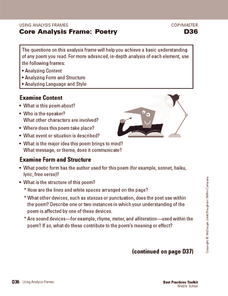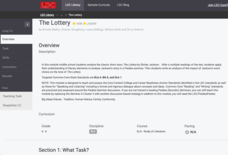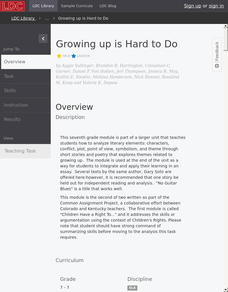Curated OER
Medieval and Renaissance Art: Botanical Symbolism
Students study the significance of flowers in art from two periods. In this Medieval and Renaissance art activity, students research the presence and meaning of botanical illustrations in twelfth, thirtieth, and fourteenth century...
Houghton Mifflin Harcourt
Core Analysis Frame: Poetry
Dig deep into any piece of poetry with a set of analysis questions. Ponder the content, form, and language of poetry and provide some question for critique. The first two pages include general questions, and the remainder of the document...
Curated OER
Figurative Language
What is figurative language, and why do we use it? Introduce your high schoolers to some examples and discuss the importance of including this element in your writing. After studying a text and searching for examples, writers will...
Moore Public Schools
Lyric Poetry
Discover lyric poetry through a reading of Sympathy by Paul Laurence Dunbar and analyze its meaning with three short-answer questions covering symbolism, personification, alliteration, metaphors, and similes.
Ontario
Critical Literacy—Media Texts
Media texts convey both overt and implied messages. As part of their study of media, class members analyze the language, form, techniques, and aesthetics in a variety of media texts.
Literacy Design Collaborative
The Lottery
Shirley Jackson's short story "The Lottery" provides middle schoolers with an opportunity to hone their close reading and literary analysis skills. After annotating their copy of the story, writer's craft an essay in which they analyze...
National Endowment for the Humanities
Theme Analysis in A Christmas Carol
Why does Charles Dickens have Ebenezer go from scrooge to light-hearted and generous? From "Bah, humbug!" to "God Bless Us, Every One!" After rereading Dickens' preface to A Christmas Carol, learners analyze quotations from the tale that...
Penguin Books
A Teacher's Guide to the Signet and Plume Editions of the Screenplay Lorraine Hansberry's Raisin in the Sun
Although they may be based on a novel, a screenplay is not a novel and is read differently. This teacher's guide to Lorraine Hansberry's Raisin in the Sun teaches readers how to read a screenplay, analyze camera instructions, and...
K20 LEARN
Where I'm From: Poetry
We carry memories of where we're from; tweens and teens can capture these memories by first listening to several memory poems and then crafting their own. They analyze literary devices other poets use, brainstorm a list of images they...
K20 LEARN
It’s Never Too Late to Apologize: Character Development and Theme in “The Scarlet Ibis”
Sometimes saying I'm sorry just doesn't cut it. Scholars examine a series of apology poems, songs, and stories and consider each speaker's regrets. Using what they have learned, they analyze James Hurst's short story, "The Scarlet Ibis,"...
K20 LEARN
It Wasn't Me: "The Crucible"
Scholars complete their study of the collective fear in Arthur Miller's "The Crucible" by conducting a mock trial to determine how many witches are in the class. Groups then analyze sections of the play for the literary devices used and...
Curated OER
Abigail and John in Love
The second instructional activity in the series asks groups to analyze an exchange of love letters between Abigail and John Adams. Scholars identify the many allusions and references in the letters and consider what they can infer about...
Curated OER
Cold Sassy Tree: Multicultural Strategy
Analyze the characters in Olive Ann Burns's Cold Sassy Tree with this assignment. After reading the majority of the novel, class members choose a character and make a visual representation of the character, including any important...
ReadWriteThink
Decoding the Dystopian Characteristics of Macintosh’s “1984” Commercial
Known as one of the most iconic advertisements of the 20th century, Macintosh's "1984" commercial has become more of a social statement. Present the ad to a new audience of viewers with a lesson plan focused on identifying dystopian...
Curated OER
The Adventures of Huckleberry Finn
Students write a paper in which they analyze a quotation or symbol from The Adventures of Huckleberry Finn. For this American literature lesson, students choose a famous quotation or symbol from the novel and analyze the importance and...
Novelinks
Lord of the Flies: Themes and Notetaking
William Golding's Lord of the Flies is a treasure trove of symbolism and literary themes. Help your kids note the richest passages in the book with a lesson and graphic organizer. The lesson prepares kids to come up with a thesis...
Curated OER
Basic Visual Language Ii: How To Analyze a Visual Text
Students identify techniques used to communicate visually. They compare and contrast different visual techniques found in mass media. They apply their understanding by creating photographs that use a variety of visual literacy techniques.
Wuthering Heights
Wuthering Heights
Finally, a reason to use those digital devices in class! Many readers appreciate the convenience of accessing reading material on digital devices. A convenient eBook contains the entire text of Emily Bronte's Wuthering Heights in digital...
K20 LEARN
Here's How I Heard It: Using Folklore To Improve Close Reading Skills
"X" is for exaggeration, and "F" is for fact. To encourage close reading and to improve literary analysis skills, class members annotate fables and tall tales, like Paul Bunyan, with symbols that identify key features of this genre.
Literacy Design Collaborative
Growing up Is Hard to Do
Looking for a fountain of youth? Scholars analyze a group of texts by Gary Soto that pertain to the difficulties of growing up. Activities pertaining to vocabulary, close reading, and shared writing prepare learners for the final task of...
Curated OER
Reading a Local and National Weather Map
Students investigate weather maps. In this weather lesson plan, students discover the meaning of different weather icons and symbols. Working independently, students use the local forecast to correctly label a state map.
Curated OER
Where are your borders?
Young scholars explore the meaning of borders, both real and symbolic. After viewing film footage and visiting poetry websites, they develop their own point of view. To express their perspective, they are to write a journalism poem, or...
Curated OER
Cartoon-Truth or Tale
Students examine Nazi propaganda. In this Holocaust lesson, students investigate the power of symbolism as they examine Nazi propaganda cartoons and then create their own cartoons using propaganda regarding current events of their choosing.
Curated OER
BE MY VALENTINE!
In this Valentine's worksheet, students read and analyze a short article about Valentine's Day and then answer five questions over the content of what they've read.

























